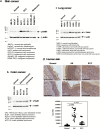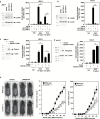LTA4H regulates cell cycle and skin carcinogenesis
- PMID: 28575166
- PMCID: PMC6248358
- DOI: 10.1093/carcin/bgx049
LTA4H regulates cell cycle and skin carcinogenesis
Abstract
Leukotriene A4 hydrolase (LTA4H), a bifunctional zinc metallo-enzyme, is reportedly overexpressed in several human cancers. Our group has focused on LTA4H as a potential target for cancer prevention and/or therapy. In the present study, we report that LTA4H is a key regulator of cell cycle at the G0/G1 phase acting by negatively regulating p27 expression in skin cancer. We found that LTA4H is overexpressed in human skin cancer tissue. Knocking out LTA4H significantly reduced skin cancer development in the 7,12-dimethylbenz(a)anthracene (DMBA)-initiated/12-O-tetradecanoylphorbol-13-acetate (TPA)-promoted two-stage skin cancer mouse model. LTA4H depletion dramatically decreased anchorage-dependent and -independent skin cancer cell growth by inducing cell cycle arrest at the G0/G1 phase. Moreover, our findings showed that depletion of LTA4H enhanced p27 protein stability, which was associated with decreased phosphorylation of CDK2 at Thr160 and inhibition of the CDK2/cyclin E complex, resulting in down-regulated p27 ubiquitination. These findings indicate that LTA4H is critical for skin carcinogenesis and is an important mediator of cell cycle and the data begin to clarify the mechanisms of LTA4H's role in cancer development.
© The Author 2017. Published by Oxford University Press. All rights reserved. For Permissions, please email: journals.permissions@oup.com.
Figures






Similar articles
-
3'-Hydroxypterostilbene Inhibits 7,12-Dimethylbenz[a]anthracene (DMBA)/12-O-Tetradecanoylphorbol-13-Acetate (TPA)-Induced Mouse Skin Carcinogenesis.Phytomedicine. 2021 Jan;81:153432. doi: 10.1016/j.phymed.2020.153432. Epub 2020 Dec 3. Phytomedicine. 2021. PMID: 33310310
-
IL-12 deficiency suppresses 12-O-tetradecanoylphorbol-13-acetate-induced skin tumor development in 7,12-dimethylbenz(a)anthracene-initiated mouse skin through inhibition of inflammation.Carcinogenesis. 2009 Nov;30(11):1970-7. doi: 10.1093/carcin/bgp228. Epub 2009 Sep 16. Carcinogenesis. 2009. PMID: 19759192 Free PMC article.
-
Azadirachta indica acts as a pro-oxidant and modulates cell cycle associated proteins during DMBA/TPA induced skin carcinogenesis in mice.Cell Biochem Funct. 2013 Jul;31(5):385-94. doi: 10.1002/cbf.2909. Epub 2012 Oct 11. Cell Biochem Funct. 2013. PMID: 23055378
-
Leukotriene A4 hydrolase as a target for cancer prevention and therapy.Curr Cancer Drug Targets. 2004 May;4(3):267-83. doi: 10.2174/1568009043333041. Curr Cancer Drug Targets. 2004. PMID: 15134534 Review.
-
Skin cancer chemoprevention by α-santalol.Front Biosci (Schol Ed). 2011 Jan 1;3(2):777-87. doi: 10.2741/s186. Front Biosci (Schol Ed). 2011. PMID: 21196411 Review.
Cited by
-
Combining discovery and targeted proteomics reveals a prognostic signature in oral cancer.Nat Commun. 2018 Sep 5;9(1):3598. doi: 10.1038/s41467-018-05696-2. Nat Commun. 2018. PMID: 30185791 Free PMC article.
-
High-accuracy prediction of colorectal cancer chemotherapy efficacy using machine learning applied to gene expression data.Front Physiol. 2024 Jan 18;14:1272206. doi: 10.3389/fphys.2023.1272206. eCollection 2023. Front Physiol. 2024. PMID: 38304289 Free PMC article.
-
Targeting LTA4H facilitates the reshaping of the immune microenvironment mediated by CCL5 and sensitizes ovarian cancer to Cisplatin.Sci China Life Sci. 2024 Jun;67(6):1226-1241. doi: 10.1007/s11427-023-2444-5. Epub 2024 Jan 25. Sci China Life Sci. 2024. PMID: 38300441
-
New Sesquiterpene Glycosides from the Flowers of Aster koraiensis and Their Inhibition Activities on EGF- and TPA-Induced Cell Transformation.Plants (Basel). 2023 Apr 20;12(8):1726. doi: 10.3390/plants12081726. Plants (Basel). 2023. PMID: 37111949 Free PMC article.
-
Exosome Liberation by Human Neutrophils under L-Amino Acid Oxidase of Calloselasma rhodostoma Venom Action.Toxins (Basel). 2023 Oct 25;15(11):625. doi: 10.3390/toxins15110625. Toxins (Basel). 2023. PMID: 37999488 Free PMC article.
References
-
- Thunnissen M.M., et al. (2002) Crystal structures of leukotriene A4 hydrolase in complex with captopril and two competitive tight-binding inhibitors. FASEB J., 16, 1648–1650. - PubMed
-
- Andersson B., et al. (2003) Crystallization and X-ray diffraction data analysis of leukotriene A4 hydrolase from Saccharomyces cerevisiae. Acta Crystallogr. D. Biol. Crystallogr., 59, 1093–1095. - PubMed
-
- Stockley R.A., et al. (2002) The effect of augmentation therapy on bronchial inflammation in alpha1-antitrypsin deficiency. Am. J. Respir. Crit. Care Med., 165, 1494–1498. - PubMed
MeSH terms
Substances
Grants and funding
LinkOut - more resources
Full Text Sources
Other Literature Sources
Medical
Molecular Biology Databases
Miscellaneous

